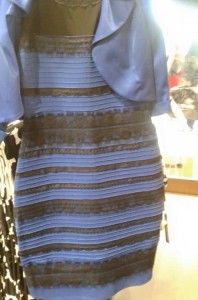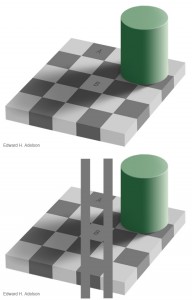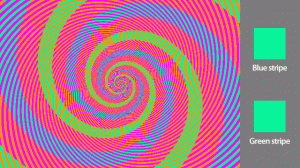Feb 27 2015
What Color Is This Dress? It’s An Optical Illusion
 This is pretty amazing – almost as much for how quickly this has gone viral as for the effect itself. There is now an intense debate going on in the intertubes over whether this dress is black and blue or white and gold. Take a look and decide for yourself. Buzzfeed has a poll which currently puts it at 72% white and gold, and 28% black and blue. Right now there are about 2 million votes, so that is probably statistically significant.
This is pretty amazing – almost as much for how quickly this has gone viral as for the effect itself. There is now an intense debate going on in the intertubes over whether this dress is black and blue or white and gold. Take a look and decide for yourself. Buzzfeed has a poll which currently puts it at 72% white and gold, and 28% black and blue. Right now there are about 2 million votes, so that is probably statistically significant.
I see black and blue, no matter what screen or version of that picture I look at. It does not seem to be an issue with the monitor or viewing conditions.
The reason, in my opinion, this has gone so viral so quickly is that people are legitimately freaked out by the realization that how they see the world is ultimately a subjective construction of our brains. Taylor Swift tweeted about the debate:
“I don’t understand this odd dress debate and feel like it’s a trick somehow. I’m confused and scared. PS It’s OBVIOUSLY BLUE AND BLACK.”
That about sums it up. She thinks it must be a trick (it is – a trick of the brain), and is scared and confused. At the same time she is caps-lock-certain that her perception of the dress’s color is the objective truth.
This is clearly an optical illusion. The type of illusion is called color constancy. Our brains evolved to favor consistency over accuracy, in both memory and perception. If we see a tiger running through a sun-dappled forest, it’s important that we perceive a constant entity, not a morphing and changing image.

The actual color that falls upon our retina will change dramatically in different lighting conditions. This might trick a perceptive system into thinking that one item is actual multiple items, divided along lines of shade and light. In order to perceive the item as the single continuous thing that it is, our brains evolved color and shading correction algorithms White, for example, will appear blue in dark light, but our brains still see white – it corrects the blue perception into white.
Here is a black and white version of this illusion – the checkerboard illusion. The shade of squares A and B are identical, but our brains see them as light and dark. It makes assumptions about shading, and then corrects for the shadow effect, so that we correctly perceive the light squares as light, even when they are in shadow.
Below is a really intense color illusion. The blue and green stripes are actually the exact same color. Our brains perceive them differently because of the surrounding colors, which force our brains to make different assumptions about shading, and therefore they correct the color in opposite directions.
The dress is a similar color constancy illusion, but is also an ambiguous stimuli illusion. Ambiguous optical illusions are ones in which our brains are given conflicting information, or there are different ways to resolve the image that are equally valid. Remember the spinning girl illusion? This remains one of my most popular posts, for the same reason this dress controversy has gone viral. Our brains can make different assumptions to “see” the girl spinning clockwise or counterclockwise. There are lots of this type of illusion – is it a young girl or old woman, which way are the cubes facing, do you see a wine glass or two faces, etc.
The photo of the dress just happens to hit the sweet spot of ambiguity in terms of lighting and shading. Different people’s brains will therefore make different assumptions and correct for either apparent overexposure or underexposure. Do you have to correct for the glare of bright lights, or the dulling of colors because of shade? Remember, white appear blue when it is shadowed, and our brains correct the blue to white. Our brains can correct the reflective part of the dress darker to be black, or the dark parts of the dress lighter to appear gold.
Conclusion
This is a fun viral phenomenon, and one that is a useful teaching moment. The dress color debate is the result of an optical illusion. Don’t be “scared and confused,” this is just how our brains work.
I want to emphasize that this is not just a isolated weird case. This is how our brains work all the time. What we perceive is a constructed illusion, based upon algorithms that make reasonable assumptions about distance, shading, size, movement, and color – but they are assumptions, none-the-less, and sometimes they can be wrong or misleading.
By the way, it appears that the dress is objectively black and blue (see the photos here), which means that 72% of people are correcting in the wrong direction.







